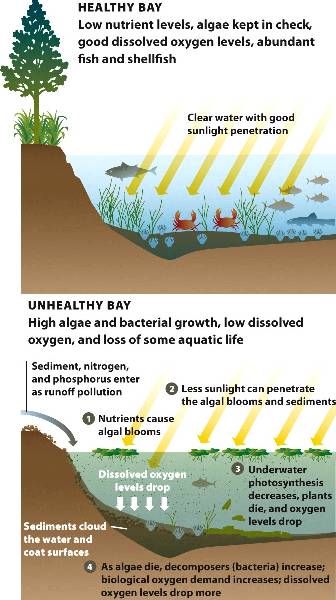Chapter 18 Self Quiz: Water Pollution
-
 A(n) ________ is an area of land over which water drains into a body of water.
A(n) ________ is an area of land over which water drains into a body of water.
- floodplain (wrong)
- upland (wrong)
- bottomland (wrong)
- estuary (wrong)
- watershed (correct)
Hint
- One factor that contributes to more dissolved oxygen in streams is
- warmer air temperature (wrong)
- cooler water temperature (correct)
- slower water movement (wrong)
- more nutrients (wrong)
- all of the above (wrong)
Hint
- The leading source of water pollution in the U.S. is
- chemicals (wrong)
- pathogens (correct)
- lead (wrong)
- mercury (wrong)
- sediments (wrong)
Hint
- Rank the following areas in ascending order (from least to most) as typical sources of nitrogen pollution in watersheds.
- forested, suburban, agricultural (correct)
- forested, agricultural, suburban (wrong)
- agricultural, forested, suburban (wrong)
- suburban, agricultural, forested (wrong)
- suburban, forested, agricultural (wrong)
Hint
-
 Excessive nutrients in aquatic ecosystems can cause explosive algal growth called
Excessive nutrients in aquatic ecosystems can cause explosive algal growth called
- bioaccumulation (wrong)
- biomagnification (wrong)
- eutrophication (correct)
- nitrification (wrong)
- denitrification (wrong)
Hint
- Permeable pavers
- promote faster water flow to streams (wrong)
- protect streambanks from erosion (wrong)
- absorb nitrogen from the atmosphere (wrong)
- allow vegetation to grow on green roofs (wrong)
- allow water to infiltrate into the ground (correct)
Hint
- A rain barrel can
- reduce stormwater runoff (correct)
- house a rain garden (wrong)
- be used to water a green roof (wrong)
- speed stormwater movement (wrong)
- all of the above (wrong)
Hint
 A(n) ________ is an area of land over which water drains into a body of water.
A(n) ________ is an area of land over which water drains into a body of water.
 Excessive nutrients in aquatic ecosystems can cause explosive algal growth called
Excessive nutrients in aquatic ecosystems can cause explosive algal growth called